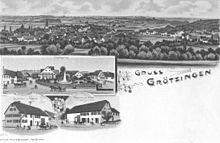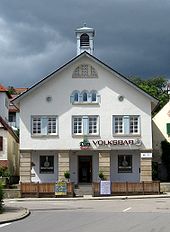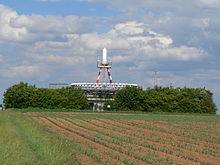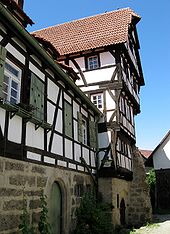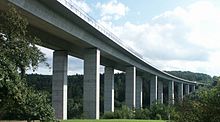Aichtal
| coat of arms | Germany map | |
|---|---|---|

|
Coordinates: 48 ° 37 ' N , 9 ° 14' E |
|
| Basic data | ||
| State : | Baden-Württemberg | |
| Administrative region : | Stuttgart | |
| County : | Esslingen | |
| Height : | 311 m above sea level NHN | |
| Area : | 23.64 km 2 | |
| Residents: | 9901 (Dec. 31, 2018) | |
| Population density : | 419 inhabitants per km 2 | |
| Postal code : | 72631 | |
| Area code : | 07127 | |
| License plate : | ES, NT | |
| Community key : | 08 1 16 081 | |
| LOCODE : | DE AIL | |
| City structure: | 3 districts | |
City administration address : |
Waldenbucher Strasse 30 72631 Aichtal |
|
| Website : | ||
| Mayor : | Lorenz Kruß | |
| Location of the city of Aichtal in the Esslingen district | ||
Aichtal ( ) is a town in the middle of Baden-Württemberg , about 18 kilometers south of the state capital Stuttgart in the Esslingen district. It belongs to the Stuttgart region (until 1992 the Middle Neckar region ) and the European metropolitan region of Stuttgart . The community, which was created in 1975 as part of the community reform, consists of the three districts of Grötzingen, Aich and Neuenhaus and has around 10,000 inhabitants.
geography
Geographical location
Aichtal is located on the southern edge of the Filder plain in the valley of the eponymous Aich , a left tributary of the Neckar . It is separated from the Neckar Valley by the ridge of Galgenberg, Kleinbergle and Schaichberg. The Neuenhaus district, located in the corner of the valley fork formed by Aich and Schaich , largely belongs to the Schönbuch Nature Park . The marl slopes of the Aichtal are covered by meadows and fruit orchards. The urban area extends from an altitude of 295 meters at the Grötzingen sewage treatment plant to 498 meters on the Betzenberg in Schönbuch .
Expansion of the urban area
The city covers an area of 23.64 square kilometers, of which 3.48 square kilometers are populated. At 10.49 square kilometers, forest areas take up almost half of the municipal area, including the 8.12 square kilometer portion of Schönbuch. The extension of the urban area is 11.0 kilometers from west to east along the Aich and 3.4 kilometers in a north-south direction.
Neighboring communities
Neighboring communities are Filderstadt in the north, Wolfschlugen in the northeast, Nürtingen in the east, Neckartailfingen and Schlaitdorf in the south, Walddorfhäslach ( Reutlingen district ) in the southwest and Waldenbuch ( Böblingen district ) in the west.
City structure
Aichtal consists of the three districts of Grötzingen (around 4300 inhabitants; 7.68 square kilometers), Aich (around 3100 inhabitants; 6.11 square kilometers) and Neuenhaus (around 2200 inhabitants; 9.85 square kilometers). Aich is home to the spatially separate Rudolfshöhe settlement, and the Bergwirtshaus residential area is attached to the Grötzingen district. Lost villages are Bombach and Mühlstetten in Aich as well as Forsthaus, Waldbruderhaus, Grünes Häusle and Brustelberg in Neuenhaus.
Division of space

According to data from the State Statistical Office , as of 2014.
history
On January 1, 1975, during the administrative reform of the city of Grötzingen and the independent communities of Aich and Neuenhaus, the new city of Grötzingen was founded with the administrative headquarters in the Aich district. After protests from Aich and Neuenhaus, where parts of the population felt downgraded by this name, the city was renamed Aichtal on August 1, 1978.
Administrative affiliation
With the implementation of the administrative structure in the Kingdom of Württemberg , the old Württemberg city of Grötzingen and the two places Aich and Neuenhaus remained assigned to the Oberamt Nürtingen in 1806 . During the district reform during the Nazi era in Württemberg , they came to the district of the same name in 1938 . In 1945 the places became part of the American zone of occupation and thus belonged to the newly founded state of Württemberg-Baden , which was incorporated into the current state of Baden-Württemberg in 1952. In 1973 the district reform took place in Baden-Württemberg , when the towns became part of the Esslingen district.
Grötzingen
On the district of Grötzingen (Swabian Gretzeng ['gret͡seŋ]) there was already a settlement in the Neolithic, located directly on the Aich. When the Aich river bed was relocated in 2008, stone tools and potsherds were found.
Gretzingan was mentioned for the first time in 1075 in a document from King Heinrich IV . It was about the vineyards in Grötzingen, which belonged to Hirsau Monastery. The Alemannic settlement emerged in the 7th century at the latest and was located in today's Altgrötzinger Valley. The name probably goes back to a clan leader named Gretz .
Presumably in the first half of the 13th century, one of the Grötzinger gentlemen built a moated castle with a farm yard in the southern part of the location marker on the Aich river. The city of Grötzingen was founded around 1275 by Knight Diepold von Bernhausen , who supported King Rudolf von Habsburg and built the city as a defense system against Nürtingen, which was growing in influence. In 1304, Grötzingen was first officially designated as a town, the inhabitants of the original village moved into its walls and the previous village fell into disrepair. In 1337 Diepold's son sold the town of Grötzingen to Württemberg .
From the 14th to the 16th century, Grötzingen was the seat of an office to which Aich, Neckartailfingen, Neckartenzlingen, Neuenhaus and Wolfschlugen belonged. Then Grötzingen came to the Nürtingen office.
During the Schmalkaldic War , the residents of Grötzingen sold their cannons out of financial difficulties in 1546. As looting soldiers approached, they dug wooden well pipes and pushed them into the loopholes in the city wall. Since the approaching soldiers took these for cannons, they moved on without attacking the city.
In the years 1634/1635, 243 Grötzinger and 194 Neckartailfinger citizens, who sought refuge here after the destruction of their place, fell victim to the plague . After the Thirty Years' War , the city only had a third of the population - Grötzingen went from being the second richest to the poorest place in the Nürtingen district. As early as the middle of the 18th century, the need forced numerous poor residents to emigrate, mostly to North America.
A major fire destroyed 13 buildings in the town center in 1845, including the town hall and the school building.
Aich
Aich was mentioned for the first time in 1103 in a deed of donation from the brothers Wernher and Wolfram von Eichacha. 1312 is a property of the Lords of Bernhausen in Aich, but they sold it in 1319 to the parish church's women's pledge. The “Vögte von Aich” appear as local nobility. They were knightly servants of the Count Palatine of Tübingen (Herrenberg line). The Bailiffs von Aich also had properties in Neuenhaus and Schlaitdorf. In 1369 the place was bought by the Reutlingen Sperwern for 550 pounds of Heller. These were then sold to Württemberg in 1382 with the Lordship of Herrenberg. Württemberg added Aich to the Grötzingen office, later, after its dissolution at the beginning of the 16th century, to the Nürtingen office. In 1383 the village had twelve "Hüblin" (small farm estates). The oldest document in the Esslingen district archive attests in 1404 that Heinz Stoll von Bernhausen was enfeoffed with the Bombachmühle, a ban mill for the Aich population; this mill can be traced back to 1369.
During the South German City War in 1449, the village was largely burned down by the Reutlingers. In 1586, Aich was again almost completely destroyed by fire and rebuilt under the direction of the ducal master builder Heinrich Schickhardt . The place was considered the geographical center of the Duchy of Württemberg.
On April 20, 1945, the place was captured and looted by French soldiers, mostly Moroccans.
Neuenhaus
On the Betzenberg there are several burial mounds from the Hallstatt period as well as numerous remains and a cemetery from the Roman period .
In 1312 Neuenhaus was first mentioned in a document as the New House ( zem Niwenhuse ). It was a moated castle of the Tübingen Count Palatine , next to which a manorial village was built. In 1347 Neuenhaus was sold to Württemberg due to financial difficulties. Until the middle of the 15th century, the Speth had the castle as a fief. The half-timbered house Schlössle was built around 1600 on the foundations of the old moated castle.
The field name Brustelberg on the slope of the Betzenberg refers to the fact that there was a medieval castle here, which was inhabited until 1670 and then fell into disrepair. After the death of the last owner, the childless Junker Phillip Grempp von Freudenstein, the castle passed into the possession of Württemberg in 1641, Friedrich von Ragowitz then received it as a kunkellehen. His widow was the last inhabitant of the castle, when she died in 1670 the castle had already fallen into disrepair.
The pottery trade was carried out in Neuenhaus from the 14th to the middle of the 20th century. The pottery clay came from nearby Betzenberg. Duke Ulrich recruited master stoners from Lower Franconia, to whom he promised free wood from the Schönbuch. In 1848 there were 78 master stoners in the village, d. H. almost two thirds of the working population exercised this profession. This gave rise to the popular Swabian place name Häfner-Nuihausa , which appears in official files as early as 1720, in contrast to the Catholic Nuihausa ( Neuhausen auf den Fildern ) , which is located about 15 km northeast . In the neighboring towns, the residents of Neuenhaus are usually simply called Häfner .
Another source of income were crabs that were caught in the Schaich and regularly sold as far as Stuttgart and Tübingen. In addition, wine was grown on the Uhlberg until 1832.
Urban and population development
In Grötzingen and Aich, new residential areas on a south-facing slope above the town center were developed from the post-war years to the 1980s. In Grötzingen these are the Schönblick settlement from 1948 and the flower settlement from 1971, in Aich the Sulzäcker (1956) and the north-east of the village Rudolfshöhe (1957) as well as the Steinenäcker and the Gemeindeberg (1973). Neuenhaus expanded from 1965 to the 1980s with new buildings along the connecting road from Waldenbuch to Nürtingen, in Grörach and in the Sandäckern as well as on the slope of the Betzenberg. From 1969, the Aichholz industrial park was built north of Aich. In 1976 the Aldi company settled in the neighboring Riedwiesen.
At the end of the 1990s, the Schönblicksiedlung was expanded to include the new development area Froschegert, as was the flower settlement around the Hohen Rain. On the northeastern outskirts of Neuenhaus, new construction areas have also been created in recent years. Further residential building sites are currently being developed in the Weckholder residential area between Grötzingen and Rudolfshöhe.
In 2004, Aichtal had 4,310 households, which corresponds to an average household size of 2.3 people. The mean age of the population was 39.9 years.
| 1572 | 1654 | 1703 | 1745 | 1803 | 1810 | 1824 | 1834 | 1843 | 1852 | 1861 | 1871 | 1885 | 1895 | 1900 | 1905 | 1910 | 1919 | |
|---|---|---|---|---|---|---|---|---|---|---|---|---|---|---|---|---|---|---|
| Grötzingen | 450 | 258 | 448 | 593 | 870 | 893 | 945 | 958 | 967 | 977 | 900 | 933 | 882 | 804 | 784 | 845 | 856 | 870 |
| Aich | 728 | 778 | 800 | 791 | 725 | 737 | 694 | 626 | 634 | 629 | 624 | 647 | ||||||
| Neuenhaus | 565 | 624 | 668 | 776 | 674 | 772 | 838 | 748 | 724 | 718 | 716 | 793 | ||||||
| all in all | 2,238 | 2,360 | 2,435 | 2,544 | 2,299 | 2,442 | 2,414 | 2,178 | 2.142 | 2,189 | 2,196 | 2,310 |
| 1925 | 1933 | 1939 | 1946 | 1950 | 1956 | 1961 | 1965 | 1970 | 1975 | 1980 | 1985 | 1990 | 1995 | 2000 | 2005 | 2010 | 2015 | |
|---|---|---|---|---|---|---|---|---|---|---|---|---|---|---|---|---|---|---|
| Grötzingen | 869 | 831 | 848 | 1,239 | 1,283 | 1,862 | 2,453 | |||||||||||
| Aich | 635 | 662 | 660 | 909 | 971 | 1,600 | 2.224 | |||||||||||
| Neuenhaus | 806 | 867 | 864 | 1,089 | 1,141 | 1,413 | 1,767 | |||||||||||
| all in all | 2,310 | 2,360 | 2,372 | 3,237 | 3,395 | 3,905 | 4,875 | 6.009 | 6,444 | 7,336 | 8,195 | 8,517 | 8,709 | 9,178 | 9,531 | 9,771 | 9,716 | 10.124 |
Population census results (until 1961 and 1970) and updates from the State Statistical Office
Religions
The three districts of Aichtal have been evangelical for centuries since the Reformation. A Catholic parish has existed in Grötzingen since 1954. There is a New Apostolic congregation in Neuenhaus, as well as a congregation of the Evangelical State Church Community Christ Association (formerly the Württemberg Brethren Association ). The Protestant parishes of Grötzingen, Aich and Neuenhaus belong to the Nürtingen parish of the Evangelical State Church in Württemberg , the Catholic parish of Grötzingen-Harthausen to the dean's office in Esslingen-Nürtingen of the Rottenburg-Stuttgart diocese .
In 1280 there is evidence of a church in Grötzingen which originally belonged to Neckartailfingen and where its own parish was established in 1375. Count Ulrich V donated the church to the hospital in Kirchheim in 1444/45. Today's town church was built around 1460 and was heavily modified in the 19th and 20th centuries. A parish church in Aich is mentioned as early as 1275. It came under Württemberg rule via the Kloster Denkendorf . Today's Albanus Church was built at the beginning of the 16th century through the conversion of a late Gothic side choir tower. 1343 a chapel in Neuenhaus is mentioned, which belonged to the parish of Weil im Schönbuch. The Bebenhausen monastery had the right of patronage . In the 16th century Neuenhaus became an independent parish. Today's church is a late Gothic building from 1480, which has been rebuilt several times and still has a choir with a ribbed vault.
politics
Administrative headquarters
The town hall, built in 1966 in the Aich district, is the administrative seat and conference venue of the municipal council.
Municipal council
The municipal council in Aichtal has 18 members. The local election on May 26, 2019 led to the following official final result. The municipal council consists of the elected voluntary councilors and the mayor as chairman. The mayor is entitled to vote in the municipal council.
| Parties and constituencies |
% 2019 |
Seats 2019 |
% 2014 |
Seats 2014 |
||
| FUW | Free Independent Electoral Association | 26.36 | 5 | 23.59 | 4th | |
| CDU / BLA | Christian Democratic Union of Germany / Aichtal Citizens List | 17.15 | 3 | 22.35 | 4th | |
| GREEN | Alliance 90 / The Greens | 23.83 | 4th | 22.16 | 4th | |
| SPD / UL | Social Democratic Party of Germany / Independent List | 14.99 | 3 | 17.46 | 3 | |
| LIBERAL | Aichtal Liberal Citizens / FDP | 17.67 | 3 | 14.44 | 3 | |
| total | 100 | 18th | 100 | 18th | ||
|---|---|---|---|---|---|---|
| voter turnout | 66.62% | 56.58% | ||||
mayor
The mayor of Baden-Württemberg is elected for a term of eight years. Lorenz Kruß was elected as the new mayor on April 22, 2012 with 50.24% of the valid votes.
- 1976–1992: Manfred Stierle
- 1992–2012: Klaus Herzog
- since July 8, 2012: Lorenz Kruß
coat of arms
Blazon: "Under a golden (yellow) shield head, inside a black deer pole, divided five times by green and gold."
Aichtal bears the coat of arms of the former city of Grötzingen, which can be traced back to 1535. It is based on the seal of the city founder Diepold von Bernhausen, supplemented by the Württemberg stag bar. Similar coats of arms can be found in today's town of Filderstadt and the former municipality of Bittenfeld , in which the noble free von Bernhausen also ruled for a time.
The city flag has the colors green-yellow (green-gold). The city of Aichtal was awarded the coat of arms and flag in 1978 by the Esslingen District Office.
Town twinning
-
 Sümeg (Hungary), since 1990
Sümeg (Hungary), since 1990 -
 Ligny-en-Barrois (France), since September 12, 1998
Ligny-en-Barrois (France), since September 12, 1998
Culture and sights
Buildings
Since the town of Grötzingen has been spared major damage in the past, several half-timbered houses from the 15th and 16th centuries have been preserved. Sights include the building at Hindenburgstrasse 17 from 1558 on the market square, which served as a school from 1738 to 1820 and is now used as a Protestant parish hall, as well as the rectory from 1683. The town church, which was built around 1460 as a new Gothic building of a much older church, changed a lot in the 19th and 20th centuries. The city founder Diepold von Bernhausen, who died in the fight against Württemberg in 1286 near Hedelfingen, was buried in the Romanesque predecessor church. Only remnants of the city wall, which was torn down at the beginning of the 19th century and had twelve towers and three gates, have been preserved. From 1968, parts of it - including the prison and powder towers - were rebuilt.
The Aichtalbrücke , built from 1979 to 1983, is the longest federal road bridge in Germany with a length of 1161 meters. It spans the Aich and Bombachtal between Aich and Neuenhaus at a height of 52 meters above the valley floor. On the Betzenberg, on the western boundary above Waldenbuch, is the Waldenbuch telecommunications tower , which was built in 1976 and can be seen from far away at a height of 146 meters. Another noticeable building from more recent times is the rotating radio beacon on the Kleinbergle, used for flight navigation .
nature
Aichtal is located directly at the Schönbuch Nature Park , the north-eastern part of which belongs to the urban area. Marked hiking trails take you to Tübingen or Herrenberg on foot or by bike without leaving the forest. The protected Schaichtal stretches between the Betzenberg and the Schaichberg over eight kilometers from Neuenhaus to Dettenhausen . The lush bank vegetation as well as lakes and ponds characterize the scenic valley, which is home to rare species such as the kingfisher, the fire salamander and the dipper.
North of New house located Uhlberg with the observation tower Uhlbergturm and barbecue, which can also be accessed directly from Aich from walking. At the Burkhardtsmühle, at the confluence of the Reichenbach and the Aich, the Siebenmühlental begins , through which an asphalt hiking trail leads to Leinfelden.
theatre
The Grötzinger Galgenberg has been used as a venue for theater performances since 1954. The Grötzingen Nature Theater performs two plays there every summer, one for children and one for adults. There is space for 850 spectators under the concrete dome built in 1978.
Museums
The Grötzingen Local History Museum and the Neuenhaus Häfnermuseum provide an insight into the past of both places.
Sports
Aichtal has three football, two tennis and two water sports clubs. Two fishing clubs, a rifle club, a table tennis club, a volleyball club and a ski and aikido club complete the sporting offer. The indoor swimming pool in Neuenhaus, which has existed since 1974, was largely demolished in the mid-1990s, rebuilt and reopened as a garden indoor swimming pool. The exposed location of the indoor pool on the edge of Schönbuch allows a view over the three parts of the city to the Kaiser Mountains .
music
There are also two music clubs in Aich and Neuenhaus, the musicians' march of the fire brigade Dept. Grötzingen, three choirs and an accordion club in Grötzingen.
Regular events
The larger events known in the region include the Grötzinger spring market (end of March), the Bock beer festival in Neuenhaus (May), the summer festival of the Musikverein in Aich (July), the Grötzinger Städtlesfest (end of July / beginning of August) and the Häfner village festival in Neuenhaus (September).
Economy and Infrastructure
traffic
The city can be reached by car in around 25 minutes from Stuttgart, Reutlingen and Tübingen via federal highways 27 and 312 . The Stuttgart Airport and the nearest connection points to the Federal Highway 8 are about ten kilometers away. The B 27 runs on the four-lane Aichtalbrücke between Aich and Neuenhaus, the B 312 on a two-lane bridge between Grötzingen and Aich. There is only a connection to the B 27 from and to Stuttgart, the connection from and towards Tübingen, which has been required by the city and industry for years, has not yet been implemented. The state road 1185 leads from Nürtingen via Aichtal and Waldenbuch to Böblingen.
The bus routes 167, 805, 808 and 809 connect Aichtal with Filderstadt-Bernhausen (connection to the S-Bahn ), Nürtingen ( Neckar-Alb-Bahn ) and Neckartenzlingen. The operator of these lines is the Aichtal-based bus company Melchinger . On weekdays, the FMO line 760 runs two to three times a day from Neuenhaus via Waldenbuch and Böblingen to the Mercedes-Benz plant in Sindelfingen. All public transport can be used at a uniform tariff within the Stuttgart Transport and Tariff Association .
employment
As of June 30, 2010, 3,654 residents were employed subject to social security contributions, of which 3,113, or 85 percent, worked as commuters outside of Aichtal. Conversely, in 2013 there were commuters who lived outside, so that a total of 2554 employees subject to social security contributions worked in Aichtal. Of these, 71 percent were in the manufacturing sector and 29 percent in the service sector. In 2010, according to figures from the Federal Employment Agency, an average of 204 people were unemployed, which corresponds to a rate of 4.7 percent.
The number of farms in Aichtal has decreased from 285 in 1961 to 18 in 2007.
Established businesses
- Putzmeister , the leading manufacturer of concrete pumps with 15 subsidiaries worldwide, has had its headquarters in Aichtal since 1971. With over 800 employees, the company is the largest employer in the city.
- Pago labeling systems , the German subsidiary of the Swiss Pago Group that has existed since 1978, produces more than three billion self-adhesive labels for product decoration in Aichtal in addition to labeling systems. Pago employs around 500 people in Aich.
- Aldi Aichtal is a regional company of the Aldi Süd retail chain , which has around 70 branches between the northern Black Forest and the Eastern Alb. The branches are supplied from the central warehouse, which was built in 1976 and expanded several times, which covers an area of 50,000 square meters.
- Today, the Kimmich sauerkraut factory is one of the last two of what used to be 17 companies that process the nationally known Filderkraut .
media
The Nürtinger Zeitung reports on what is happening in Aichtal . In addition, the Stuttgarter Zeitung and the Stuttgarter Nachrichten are each distributed with the local section for the Esslingen district. The municipal newsletter has been published weekly since 1975 . Weekly advertising papers are the Filder-Extra and the Nürtinger Echo . The Aichtaler Echo was also published from 1995 to 2010 .
Public facilities
The Aichtal Voluntary Fire Brigade is responsible for fire fighting and accident relief in the city area. It consists of active departments in each of the three districts with a total of 10 emergency vehicles, a music department in Grötzingen and a youth fire brigade.
There are ten municipal kindergartens in Aichtal - five in Grötzingen, three in Aich, two in Neuenhaus - and an additional Waldorf kindergarten in Grötzingen.
The youth and children's home is open daily for young people between the ages of six and 25. Outside, a halfpipe , a volleyball court and a streetball facility can be used. Games such as billiards, table football, table tennis or darts and internet PCs are available in the house. Regular events include discos, rock concerts, and movie nights.
The Aichtal city library in Grötzinger Helenenheim with a stock of 21,000 media is open to all citizens.
education
In addition to the primary and secondary school in Grötzingen with the Werkrealschule, which offers all-day care, there are primary schools in Aich and Neuenhaus. Secondary schools are located in the neighboring cities of Nürtingen and Filderstadt as well as in Neckartenzlingen. The Nürtingen Adult Education Center has a branch in Aichtal. There was also the Karl Schubert seminar in the Neuenhaus district, an anthroposophical specialist school for social affairs, where the theoretical part of the training to become a state-approved curative nurse can be completed. The seminar has been in Wolfschlugen since 2011 .
Supply and disposal
Power supply
Grötzingen has been supplied with electricity since 1910, Aich and Neuenhaus since 1912. The power grid is now operated by EnBW Regional AG.
Gas supply
There is a gas supply in the districts of Aich and Grötzingen, where a natural gas network is operated by EnBW Regional AG.
Water supply
Aichtal is a member of the special purpose associations Filderwasserversorgung (Fiwa) and Bodensee water supply (BWV). Grötzingen has been partially supplied with Neckar water from Neckartailfingen by Fiwa since 1943 and completely since 1951, as has Aich since 1957. The water for Neuenhaus is obtained from its own Mönchsquelle and, since 1970, also from BWV. The daily per capita consumption averages 121 liters.
Sewage disposal
The city operates a sewage treatment plant east of Grötzingen to purify the wastewater.
Waste disposal
Waste disposal is organized by the Esslingen waste management company, which is owned by the Esslingen district.
Personalities
sons and daughters of the town
- Christoph Binder (1519–1596), Protestant clergyman, abbot of the Adelberg Monastery
- Peter Maiwald (1946–2008), writer
- Angelika Matt-Heidecker (* 1953), lawyer and politician (SPD)
- Peter Bäuerle (* 1956 in the Grötzingen district), chemist
Personalities who have worked on site
- Paul Maar (* 1937), the children's book author, lived in the Grötzingen district for a few years.
literature
- Günter Klock (ed.): Aichtal in old views. European Library, Zaltbommel / Netherlands 1998, ISBN 90-288-6566-7 .
- Günter Klock (Ed.): Grötzingen - Insights into the past. Geiger, Horb 1987, ISBN 3-89264-160-9 .
- The state of Baden-Württemberg. Volume 3. Kohlhammer, Stuttgart 1978, ISBN 3-17-004758-2 , pp. 183-186.
- Local chronicle of the community of Neuenhaus (Häfner-Neuhausen). Community administration Neuenhaus 1973.
- Erich Keyser (Ed.): Württembergisches Städtebuch. Kohlhammer, Stuttgart 1962, pp. 101-102.
- Hans Schwenkel : Home book of the Nürtingen district. Volume II. Nürtingen District Association 1953, pp. 65–80 / 259–282 / 692–707.
- Otto Schuster: Local history of the city of Grötzingen. Karl Henzler printing works, Nürtingen 1929.
- The district of Esslingen - published by the Baden-Württemberg State Archives. V. with the district of Esslingen, Jan Thorbecke Verlag, Ostfildern 2009, ISBN 978-3-7995-0842-1 , Volume 1, pages 233-251.
- Bodo Cichy: The walls of Grötzingen, Esslingen district. Preservation of monuments in a small township. In: Denkmalpflege in Baden-Württemberg , 2nd year 1973, issue 3, pp. 16-25. ( PDF; 10.3 MB )
Web links
Individual evidence
- ↑ State Statistical Office Baden-Württemberg - Population by nationality and gender on December 31, 2018 (CSV file) ( help on this ).
- ^ The state of Baden-Württemberg. Official description by district and municipality. Volume III: Stuttgart District, Middle Neckar Regional Association. Kohlhammer, Stuttgart 1978, ISBN 3-17-004758-2 , pp. 183-186.
- ↑ State Statistical Office, area since 1988 according to actual use for Aichtal.
- ^ Federal Statistical Office (ed.): Historical municipality directory for the Federal Republic of Germany. Name, border and key number changes in municipalities, counties and administrative districts from May 27, 1970 to December 31, 1982 . W. Kohlhammer, Stuttgart / Mainz 1983, ISBN 3-17-003263-1 , p. 461 .
- ^ Esslingen district, archive history accessed on June 21, 2010
- ^ Lutz Reichardt: Place name book of the Esslingen district. P. 75
- ^ Lutz Reichardt: Place name book of the Esslingen district. P. 77
- ↑ Election portal of the Nürtinger Zeitung
- ↑ BDEW (Ed.): Map of the electricity network operator 2012. Frankfurt 2012.
- ↑ BDEW (Ed.): Map of the gas network operators 2012. Frankfurt 2012.



